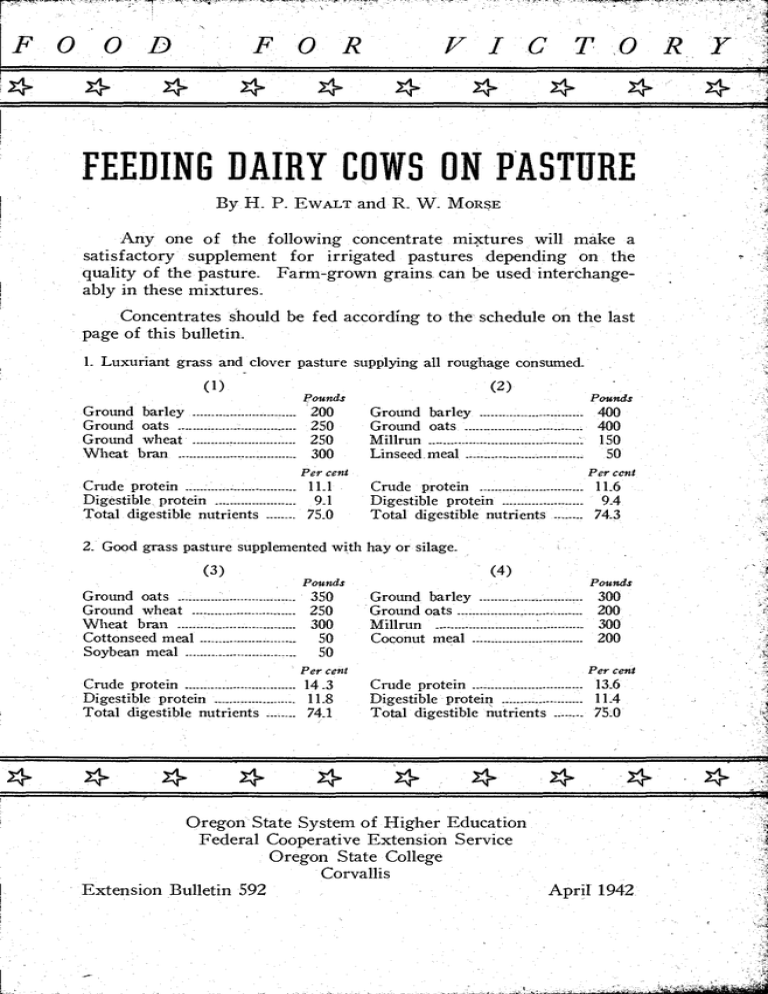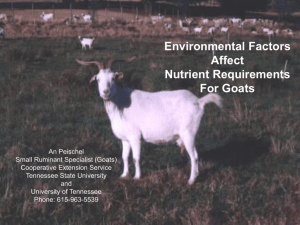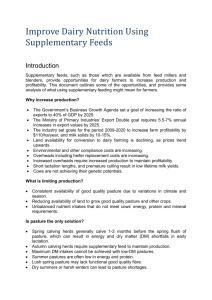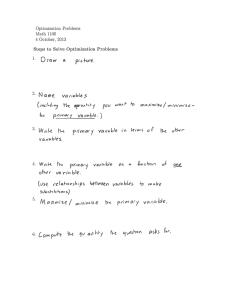VICTORY FOOD FOR *
advertisement

FOOD FOR * * * * VICTORY * * * * * FEEDING DAIRY COWS ON PASTURE By H. P. EWALT and R. W. MORSE Any one of the following concentrate mixtures will make a satisfactory supplement for irrigated pastures depending on the quality of the pasture. Farm-grown grains can be used interchangeably in these mixtures. Concentrates should be fed according to the schedule on the last page of this bulletin. 1. Luxuriant grass and clover pasture supplying all roughage consumed. (1) Ground barley Ground oats Ground wheat Wheat bran 200 250 250 300 Per cent Crude protein Digestible protein Total digestible nutrients (2) Pounds 11.1 9.1 75.0 Ground barley Ground oats Millrun Linseed meal Crude protein Digestible protein Total digestible nutrients Pounds 400 400 150 50 Per cent 11.6 9.4 74.3 2. Good grass pasture supplemented with hay or silage. (3) Ground oats Ground wheat (4) Pounds 350 250 300 Wheat bran Cottonseed meal Soybean meal 50 50 Ground barley Ground oats Millrun Coconut meal Pounds 300 200 300 200 Crude protein Digestible protein Total digestible nutrients Per cent 13.6 11.4 75.0 Per cent Crude protein Digestible protein Total digestible nutrients 14.3 11S 74.1 Oregon State System of Higher Education Federal Cooperative Extension Service Oregon State College Corvallis Extension Bulletin 592 April 1942 * 2 EXTENSION BULLETIN 592 IMPROVE FEEDING PRACTICES The need for increased milk production can be met by improved feeding practices. This is a sound approach to greater production. With the present ratio between feed and butterfat prices, improved feeding practices will mean more profit. The fundamental steps in better feeding are : Provide cheapest feed possible, such as irrigated pasture. Feed generously 365 days each year. Feed according to individual production. Feed cheapest, highest quality roughages and concentrates. Pasture is the cheapest, most palatable, and most digestible roughage obtainable for dairy cows. HOW MUCH PASTURE FORAGE CAN A COW EAT? On lush irrigated grass and clover pasture the average cow will consume from 100 to 125 pounds of forage daily. A large cow may consume 150 pounds daily. On short over-grazed pasture a cow might be limited to 50 pounds or less of forage daily. Under these conditions a cow consuming 100 pounds daily of grass and clover pasture will receive 3.1 pounds of digestible protein and 15.2 pounds of total digestible nutrients. This amount of feed will maintain a 1000-pound cow and enable her to produce about 18 pounds of 5 per cent milk daily. The consumption of forage will depend upon the grazing ability of the cow, and the palatability and abundance of the forage. CONCENTRATES NECESSARY TO SUPPLEMENT PASTURE A cow can consume only a certain amount of forage and, because of the bulk, must have additional feed in a concentrated form such as grain. Grain should be fed according to production. Good pasture supplies a comparatively high amount of digestible protein so the requirement for protein in the concentrate mixture is compara- tively low. A mixture of oats, barley or wheat, and millrun will meet the protein requirements for most concentrate supplements for pasture. Feeding excess protein is costly and should be carefully checked when considering feed requirements. Due to the variation in forage consumption by individual cows, some will refuse the recommended amounts of concentrates. This refusal may be temporary and efforts should be made regularly to FEEDING DAIRY COWS ON PASTURE get cows to consume the amounts indicated in the grain feeding schedule. The protein content of the concentrate mixture should be increased when hay or silage or both are added to the ration. HAY WITH PASTURE Feeding a small amount of hay daily in addition to necessary grain is a good practice with the use of average pastures. The pastures may not supply enough total feed and therefore must be supple- mented. When pastures are lush, hay should not be fed because pasture is the cheapest roughage and should be used to the full extent. In late summer the grass may grow slower and may not be consumed as readily by the cow. At this time pasture should be supplemented by hay or silage feeding or both. Additional roughage fed with pasture should be limited to encourage maximum grazing. SILAGE WITH PASTURE Silage of any kind may be used as additional feed for cows on pasture. As with hay the amount fed should be limited to encourage pasture grazing. Excess early pasture may be made into silage and used to supplement late summer pasture. DRY-LAND PASTURE Dry-land pasture either native or cultivated will depend on late spring rains for continued growth. Such pasture declines rapidly early in the summer. Native pasture seldom supplies enough forage to meet the total roughage requirement of a cow and therefore should be supplemented from the start. Green pasture is not always sufficient pasture. Sudan grass does well in some areas as a late summer pasture. PASTURE MANAGEMENT POINTERS Establish a good stand of recommended grasses and clovers. Fertilize well each year. Irrigate frequently. Do not graze forage too closely. Rotate cows from one field to another allowing 6 to 10 inches growth of pasture. Stop grazing early enough in fall to allow some plant growth before winter. 4 EXTENSION BULLETIN 592 Schedule of Concentrate Feeding to Cows on Excellent, Good, and Fair Irrigated Pastures Amount of Concentrate to Feed Daily Pounds Milk Produced Daily 3.0 Per cent 16.5 19.0 22.0 24.5 27.0 30.0 32.5 35.5 38.0 41.0 43.5 46.0 49.0 52.0 54.5 57.0 60.0 62.5 65.5 4.0 5.0 6.0 Per cent Per cent Per cent 14.0 16.0 18.5 12.0 14.0 16.0 18.0 20.0 10.5 12.0 14.0 16.0 17.5 19.5 21.0 23.0 25.5 27.5 30.0 32.5 34.5 37.0 39.0 41.5 44.0 46.0 48.5 50.5 53.0 55.0 22.0 24.0 26.0 28.0 30.0 32.0 34.0 36.0 38.0 40.0 42.0 44.0 46.0 48.0 21.0 23.0 24.5 26.5 28.0 30.0 32.0 33.5 35.5 37.5 39.0 41.0 42.5 With Excellent Pasture None None None With Good Pasture With Fair Pasture None 2 1 3 2 4 1 3 5 2 4 6 3 5 7 4 6 8 5 7 9 6 8 8 9 10 11 12 13 10 11 12 13 7. 10 11 12 13 14 15 16* 9 14 15 16* 17* 18* 14 15 16* 17* 18* 19* 20* * No more concentrates should be fed than the cow can eat and digest without going off feed regardless of the amount required to maintain production. Cows that do not consume the recommended amount are either consuming more forage than the average or they are utilizing body fat. For this reason cows should be maintained in good flesh during 'lactation period and should be fattened during dry period. Fat put on during the dry period may be utilized during early lactation on pasture when they may not be able to consume enough feed to meet their requirements. Cooperative Extension Work in Agriculture and Home Economics Wm. A. Schoenfeld, Director Oregon State College and United States Department of Agriculture, Cooperating Printed and distributed in furtherance a the Acts of Congress of May 8 and June 30, 1914








